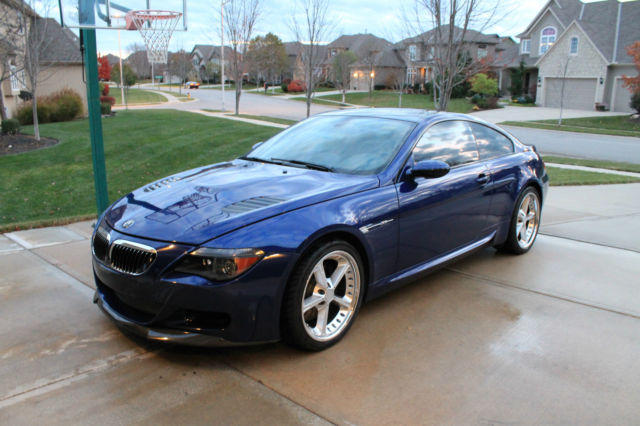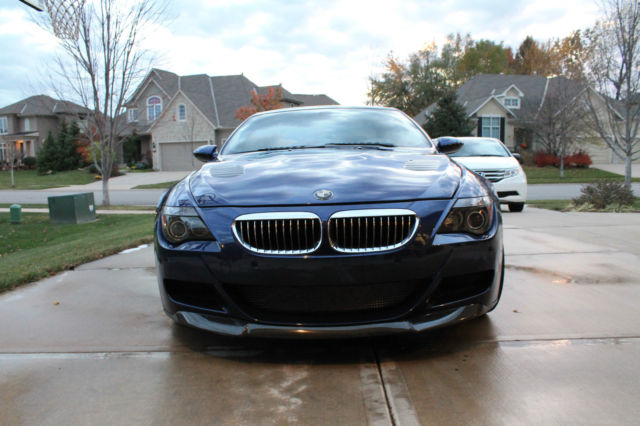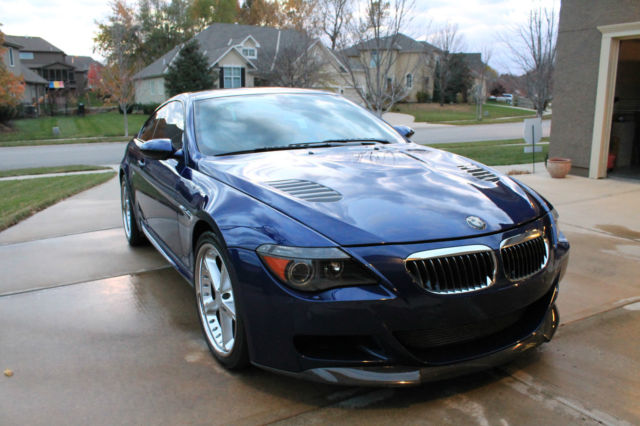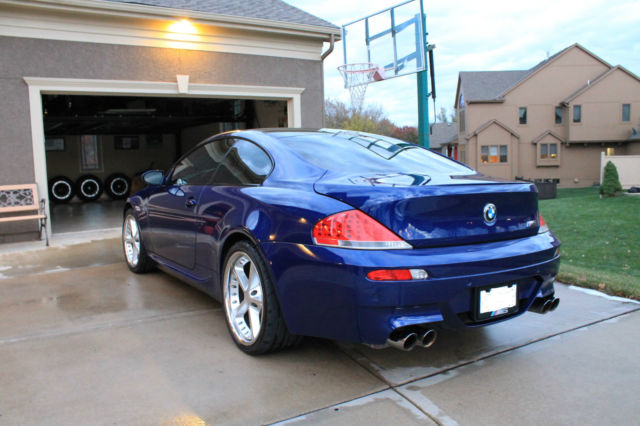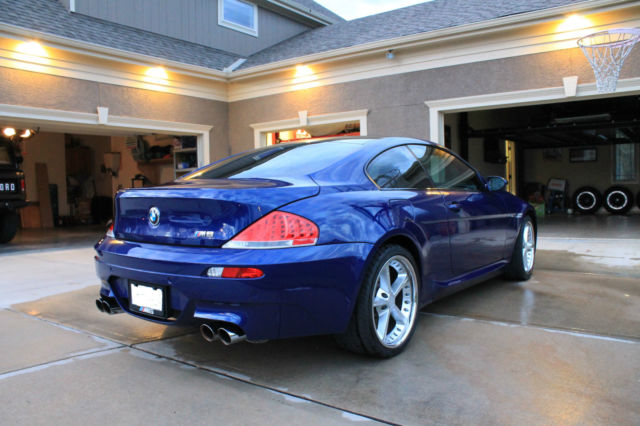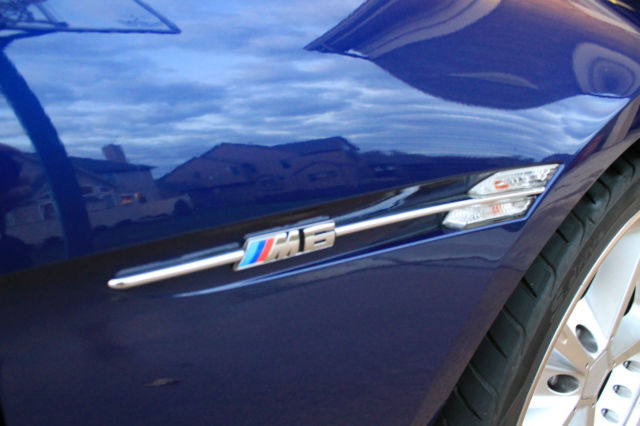2007 BMW M6 Coupe 2-Door V10
- Condition: Used
- Make: BMW
- Model: M6
- Type: Coupe
- Trim: Coupe 2-Door
- Year: 2007
- Mileage: 44,600
- VIN: WBSEH93547CY23865
- Color: Blue
- Engine size: 5.0L 4999CC V10 GAS DOHC Naturally Aspirated
- Number of cylinders: 10
- Power options: Air Conditioning, Cruise Control, Power Locks, Power Windows, Power Seats
- Fuel: Gasoline
- Transmission: Manual
- Drive type: RWD
- Interior color: Black
- Safety options: Anti-Lock Brakes, Driver Airbag, Passenger Airbag, Side Airbags
- Options: CD Player, Leather Seats, Navigation, Bluetooth Phone Connection, Ipod Connection, Front and Rear Park Assist
- Vehicle Title: Clear
- Interested?
2007 BMW M6 Coupe 2-Door Description
2007 BMW M6. 44,000 miles. V-10, Around 600 hp. Interlagos Blue with black leather interior. Carbon Fiber interior trim. Heads-up display. Rare 6-speed manual transmission. Navagation, Bluetooth Phone, Ipod, Front and Rear Park Assist.Xenon headlights with blue neon angel eyes.
$110,000 original price and $20,000 in upgrades. Painted carbon fiber hood, carbon fiber roof. 20" AC Schnitzer wheels. New tires. Underdrive pulleys, custom tune with 3500 rpm launch control. Custom exhaust with cut-outs. Aluminum M6 pedals. Carbon fiber chin spoiler. Dual cold air intake setup. All services up to date except time for spark plug replacement. Paint is in great shape.
Adult car lover driven. Always garaged. Non smoker.
More about this model:
"You can easily become addicted to this vehicle," said BMW board member, Burkhard Goeschel.
He's not kidding. After a morning that passed all too quickly, scampering around the Race Resort Ascari track outside Seville, Spain, we're believers. The 2007 BMW M6 betters the performance of most hyperexpensive exotics in a relatively unassuming-looking package, with comfortable accommodations for four (well, two adults and two kids), and enough high-tech whizbang included to satisfy a nuclear physicist.
Thankfully, we were on a track because if we had driven the M6 anywhere near its limits on the highway, we'd be writing this from a Spanish prison. Leave it to BMW's speed-obsessed M Sport engineers to adapt elements of their screaming Formula One V10 to street clothes. No, you can't rev this engine to an ear-splitting 18,000 rpm like Nick Heidfeld's FW27 BMW F1 car, but the shriek of the V10 topping its lofty 8,250-rpm redline will certainly suffice.
Thoroughbred Horsepower
The compact 529-pound, 90-degree V10 shares the F1 engine's valvetrain technology and crankcase construction. BMW eschewed superchargers and turbochargers for this 5.0-liter engine. Instead, its concept of lightweight, high-revving double VANOS variable camshaft management, weight-optimized pistons and 12-to-1 compression ratio saves weight and delivers the goods. The peak torque, 383 pound-feet, comes at 6,100 rpm but you get 80 percent of it from 3,500 to 5,500 rpm, just where you want it.
Each cylinder has its own individually managed, electronically controlled throttle butterfly for split-second throttle response. The exhaust flows from optimized five-into-one headers on each bank, and then into characteristic quad tailpipes.
For valet parking, inexperienced drivers, inclement weather motoring or just to simplify low-speed maneuvers, the V10's torrid, 507-bhp output (500 for the U.S.) can be reduced to 400-bhp with the flick of a switch.
Although BMW left its electronically controlled roll bars and run-flat tires off the M6, there's plenty of fascinating, drive-enhancing wizardry to satisfy the most inquiring minds. Start with the seven-speed Sequential Manual Gearbox (SMG) automatic transmission. Take a few minutes to learn its operation and you won't miss that little old clutch pedal one bit.
Hammer the throttle and, because the singing V10 revs so freely and fast, the SMG makes its electrohydraulic shifts verrry quickly. And with smaller gear increments than a six-speed, acceleration is enhanced.
Get With the Programming
To the left of the console-mounted shifter, lighted buttons let you preset engine power, Dynamic Stability Control (DSC), Electronic Damping Control (EDC) and the SMG transmission's shift speed. When you switch off the DSC, it's completely off, unlike other makes where company lawyers insist some electronic safeguards remain.
The EDC has three settings: Normal, Comfort and Sport. While you're making that selection, you can program a head-up tachometer display that's projected onto the windscreen. You don't have to use BMW's dreaded iDrive to arrange the shifts and shocks to your liking, but the M6's MDrive machinations didn't look much easier. We'd suggest you work out the settings you like, and keep the F1-inspired Launch Control function (it limits wheelspin in hard starts to what BMW says is an optimum 18 percent) switched off unless you're doing serious drag racing.
BMW's engineers astutely tailored the M6 for ultralight high performance. The entire roof panel, as well as the front bumper supports, are lightweight carbon fiber and stronger than steel. The front side panels are thermoplastic; the rear deck lid is sheet molding compound. Considerable use of aluminum shaves the M6's weight to just 3,771 pounds. The M6's subsequently lower center of gravity, short wheelbase and wide track contribute to its superior handling.
Out on the Ascari circuit, with all programmable systems maxed, the M6 is transformed from a surprisingly tractable street machine into an animalistic M-weapon that's just short of a competition coupe.
Hot to Handle
Switch off DSC and you can drift the M6 with aplomb. The third-generation SMG works wonderfully, blipping the throttle expertly before blindingly fast downshifts and upshifting with agility that will win most stoplight races. If you think you're pretty good, the M6 will make you feel invincible. Drivelogic has 11 possible settings. The higher the program, the quicker it shifts.
As you'd expect, the M6 is equipped with brakes whose stopping power would do credit to a racecar. Surprisingly, the massive ventilated discs employ twin-piston calipers all around, but they work so well, you won't be speculating why they're not four-pot fronts. The forged aluminum wheels, big 19-inchers with five double spokes each, are 4 pounds lighter than conventional alloys, further reducing unsprung weight. Specially developed tires -- 255/40ZR-19s in front and 285/35ZR-19s in back -- offer killer grip in wet or dry conditions. There's no spare, but if you do get a flat, there's a MMS Mobility System patch kit that will seal a hole up to 6mm.
Underneath, the alloy suspension retains the 6 Series' geometry, with a tad more negative camber to compensate for the M6's driving dynamics and likely higher suspension loads. The Servotronic steering is road- and engine-speed sensitive.
The rear end's Variable M Differential lock splits traction and supplies more to the wheel with the best grip in nanoseconds. This is especially helpful when you're accelerating out of a tight turn, and as much as 100 percent of the power can go to one drive wheel if that's where the grip is. The M Dynamic mode (BMW suggests you just use this feature on a track) is a DSC subfunction that intervenes only when the M6 is at its absolute cornering limits. A little light flashes to tell you M Dynamic is activated, but you'll be too busy countersteering to see it!
Breeding Between the Lines
We found a lot to like about the way Chris Bangle and his styling crew rearranged some of the M6's visual highlights. There's its aggressive front airdam with two large cooling slots in the lower corners flanking the wide central grille. And its distinctly wedge-shaped profile further enhances a dramatic BMW styling theme seen most recently in the latest 3 Series.
Twin, sharply drawn character lines emerge from the narrowly focused headlights, then split at the A-pillar to define the racy roofline, then simultaneously streak rearward to embrace the slightly raised (and aerodynamically efficient) deck lid and rear diffuser. The side sills are more aggressively cut than the standard M6's. We're told they optimize airflow along the underfloor (which itself has been designed to best manage aerodynamics) while visually accentuating the car's length. Like many cars, the M6 is color sensitive: Indianapolis Red is a surefire "ticket me, Officer" shade, while Sepang Bronze is more subdued, along with Alpine White nonmetallic. The car flat-out disappears in Interlagos Blue. Best bet? Go for the Silverstone II M metallic.
So Deep Within
Inside, you get it all: a twin-shroud dash that separates the serious driving accoutrements from the nav system and other center stack ancillaries. We loved the kilometer-deep, fabulously supportive bucket seats with electronic lumbar support and side bolsters; the large, easy-to-read instrument dials; a fat, grippy race-oriented steering wheel; excellent fit and posh finishes; scads of Merino quality leather and aluminum; and every possible safety aid.
What Price, Paradise?
Although U.S. prices are far from determined yet, figure on around $100 grand when the M6 hits dealerships in May of next year. It will likely come standard with virtually every BMW luxo-option -- you can always pay a bit more for such niceties as full Merino leather upholstery, with the dashboard, door and rear side panels covered in soft napa, Pianopaint Black, Madeira or Carrera wood trim and even an Alcantara headliner.
As we returned to our hotel from spirited track driving at Ascari, the temptation to pass long lines of slow-moving SEATs occurred again and again. Naturally, we couldn't always resist. The fact that we're writing this safely back in the good old USA is fortuitous -- the M6 will tempt you to test its high limits; it certainly seduced us.
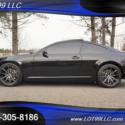 2007 BMW 650i Coupe 19K Actual Miles Loaded Automatic 2-Door Coupe
2007 BMW 650i Coupe 19K Actual Miles Loaded Automatic 2-Door Coupe
Mileage: 19,953
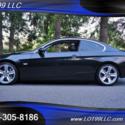 2007 BMW 335i Coupe Onl7 74K Twin Turbo Navi Automatic 2-Door Coupe
2007 BMW 335i Coupe Onl7 74K Twin Turbo Navi Automatic 2-Door Coupe
Mileage: 74,472
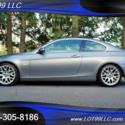 2007 BMW 328i Coupe Sport Heated Leather 3.0L I6 230hp Automatic 2-Door Coupe
2007 BMW 328i Coupe Sport Heated Leather 3.0L I6 230hp Automatic 2-Door Coupe
Mileage: 127,425
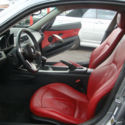 2007 BMW Z4 Coupe 3.0si Coupe 2-Door 3.0L California car Rare
2007 BMW Z4 Coupe 3.0si Coupe 2-Door 3.0L California car Rare
Mileage: 68,000
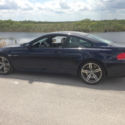 2007 BMW M6 Base Coupe 2-Door 5.0L
2007 BMW M6 Base Coupe 2-Door 5.0L
Mileage: 89,641
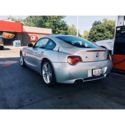 2007 BMW Z4 M Coupe Coupe 2-Door 3.2L
2007 BMW Z4 M Coupe Coupe 2-Door 3.2L
Mileage: 79,400
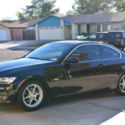 2007 BMW 328i Base Coupe 2-Door 3.0L
2007 BMW 328i Base Coupe 2-Door 3.0L
Mileage: 139,500
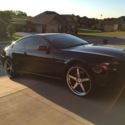 2007 BMW 650i Base Coupe 2-Door 4.8L
2007 BMW 650i Base Coupe 2-Door 4.8L
Mileage: 63,500
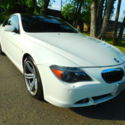 2007 BMW 650i Coupe PREMIUM 2-Door 4.8L
2007 BMW 650i Coupe PREMIUM 2-Door 4.8L
Mileage: 119,859
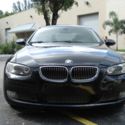 2007 BMW 335i Base Coupe 2-Door 3.0L
2007 BMW 335i Base Coupe 2-Door 3.0L
Mileage: 111,042
